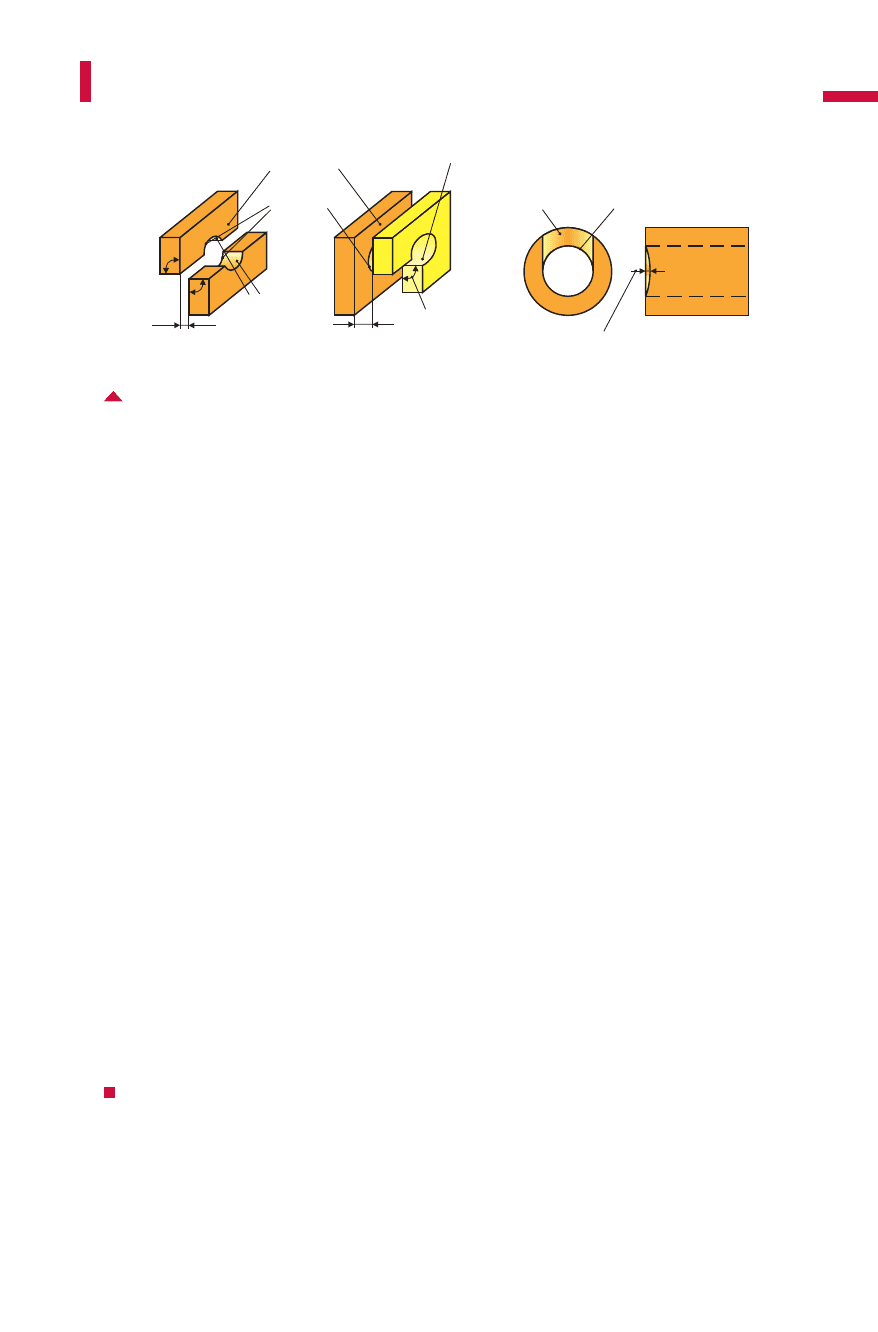Altan T. Metal Forming Handbook
Подождите немного. Документ загружается.


content, for example from 0.45 to 1.0%, can be easily formed, i.e.
without costly intermediate heat treatment. Inductive hardening steels
such as Cf 53, Cf 60 and the ball bearing steels 100 Cr 6 are classical
examples of application for warm forming. For practice-oriented calcu-
lation of force and energy requirements, a good approximation for the
flow stress curve for hot forging can be obtained by multiplying the cold
forging flow curve values with a factor of 0.3 to 0.5.Figure 6.3.1indicates
the temperature-dependent variation of the flow stress curves for Ck 15
and Cf 53.
Table 6.3.1 provides a summary of the most important steel material
groups. It lists not only the DIN and Eurostandard designations but also
the abbreviations for similar materials in accordance with the American
AISI and A.S.T.M standards as well as with the Japanese JIS standard.
The last column provides information on whether the steel is suitable
for hot forming (H), warm forming (W) or cold forming (C). For more
information on workpiece materials, please refer to DIN worksheets
17006, 17100, 17200, 17210, 17240, 17440. Flow stress curves for cold
forming are given in the VDI Guidelines 3134, 3200 sheet 2 (ferrous
metals) and sheet 3 (non-ferrous metals).
451
Materials, billet production and surface treatment
Fig. 6.3.1 Temperature-dependent flow curves Ck15 and Cf 53
truestrain [-]
flow stress k [N/mm ]
f
2
200
400
600
800
1000
materialCk15
materialCf53
0,2 0,4 0,6 0,8 1,0
0,2 0,4 0,6 0,8 1,0
20°C
500°C
600°C
700°C
800°C
20°C
500°C
600°C
700°C
800°C
=40s
-1
=40s
-1
Metal Forming Handbook / Schuler (c) Springer-Verlag Berlin Heidelberg 1998

452
Solid forming (Forging)
Table 6.3.1: Selection of steels for solid forming
Material group No. DIN 1654 Eurostandard American Japanese Suitable for cold (C),
standard AISI standard warm (W)
A.S.T.M. JIS and hot (H) forming
general 1.0303 QSt 32-3 C4C Armco C
structural steel 1.0213 QSt 34-3 C7C SS34 C
1.0204 UQSt 36 C11G1C C
1.0160 UPSt37-2 H
1.0224 UQSt-38 C14G1C SS41 C
1.0538 PSt50-2 H
case-hardening 1.0301 C10 C10 C1008 S10C W, H
steels 1.1121 Ck10 C10E C1010 S 9CK C, W, H
1.1122 Cq10 C10C C1010 S 9CK C, H
1.0401 C15 C15 S15C W, H
1.1141 Ck15 C15E C1015 S15CK C, W, H
1.1142 Cq15 C15C C1015 S15Ck C
1.5919 15CrNi6 C
1.7016 17Cr3 C
1.7131 16MnCr5 SCr22 C, W, H
1.7321 20MoCr4 C
heat-treatable 1.6523 21NiCrMo2 C
steels 1.1151 Ck22 C22E C1020 S20C C
1.1152 Cq22 C22C C1020 C
1.0501 C35 S30C W, H
1.1181 Ck35 C35E C1035 S35K C, W
1.1172 Cq35 C35C S35K C, W, H
1.0503 C45 S40C W, H
1.1191 Ck45 C45E C1045 S45C C, W, H
1.1192 Cq45 C45C C
1.1193 Cf45 C45G W
1.1213 Cf53 C53G W
– Cf60 C60G W
alloyed 1.5508 22B2 C
heat-treatable 1.5510 28B2 C
steels 1.5511 35B2 C
1.5523 19MnB4 C
1.7076 32CrB4 C
1.7033 34Cr4 5130/-40 SCr1 C, W, H
1.7035 41Cr4 5130/-40 SCr4 C, W, H
1.7218 25CrMo4 4120/32 C, W, H
1.7220 34CrMo4 4135 SCM3 C, W, H
1.7225 42CrMo4 4140/-42 SCM4 C, W, H
1.6582 34CrNiMo6 C, H
stainless steels 1.4016 X6Cr17 C, ferritic
1.4006 X10Cr13 X10Cr13 C, martensitic
1.4024 X15Cr13 X15Cr13 C, H, austenitic
1.4303 X5CrNi18-12 X4CrNi18-12 C, austenitic
1.4567 X3CrNiCu18-9 X3CrNiCu18-9-4 C, austenitic
roller bearing steel 1.3505 100Cr6 52100 SUJ1/2 C, W
Metal Forming Handbook / Schuler (c) Springer-Verlag Berlin Heidelberg 1998

Aluminium alloys
Wrought aluminium materials which have been manufactured by form-
ing, not casting, are used for forming processes. Aluminium with a fine-
grained microstructure offers a number of advantages over coarser-
grained aluminium: Improved formability, superior surface quality of
components and greater strength. Ultra-pure and pure aluminium (Table
6.3.2) permit an extrusion ratio (cross-sectional reduction) of up to 95%
(tube production). With an increasing magnesium content, it is possible
to set higher strength characteristics. Age-hardenable, corrosion-resistant
aluminium alloys such as A1MgSi1 exhibit high strength characteristics
as a result of heat ageing which exceed the values achieved when in a
strain-hardened state. Flow curves for aluminium materials are also giv-
en in the VDI directives 3134 and 3200.
Copper alloys
Like aluminium, copper and its alloys offer outstanding extrusion capa-
bility. The yield stress increases with increasing alloying elements,
whereby forming should take place while the material is in a soft-
annealed state. In the case of technically pure copper, mainly E-Cu and
SE-Cu are used, for example, in the production of terminals. Among the
variety of different bronzes used, the tin bronze with 1 to 2 % Sn and sil-
icon bronze is most widely formed. If alloy elements such as chrome, zir-
conium, berylium or silicon (CuNi2Si) are present, many copper materi-
453
Materials, billet production and surface treatment
Material group No. DIN 1712/25/45 ISO AA JIS
pure/ultra-pure aluminium 3.0285 Al 99,8 Al 99,8 1080A A1080
3.0275 Al 99,7 Al 99,7 1070A A1070
3.0255 Al 99,5 Al 99,5 1050A A1050
non age-hardenable alloys 3.0515 Al Mn1 AlMn1 3103 A3003
3.3315 Al Mg1 AlMg1 5005A
3.3535 Al Mg3 AlMg2,5 5754
3.3555 Al Mg5 AlMg5 5056A
hardenable alloys 3.3206 Al Mg Si 0,5 6060 (6063) A6063
3.2315 AlMgSi 1 6082 (6061) A6082
3.1325 AlCuMg 1 2017A A2017
3.4365 AlZnMgCu 1,5 7075 A7075
Table 6.3.2: Selection of aluminium materials for cold and hot extrusion
Metal Forming Handbook / Schuler (c) Springer-Verlag Berlin Heidelberg 1998

Material group Abbreviation No. DIN US designation / UNS JIS
pure copper E-Cu F20 2.0060 1787 ETP 99,95 C0-0,04O / C11000 OFCu
SF-Cu 2.0090 1787 DHP Copper / C12200 DCu
copper alloys CuZn10 2.0230.10 17660 Commercial copper / C22000 BS( ), RBS ( )
CuZn28 2.0261.10 17660 Cartridge brass 70 % / C26000 RBS ( )
CuZn40 2.0360 17660 Muntz Metal / C28000 RBS ( )
CuNi2Si 2.0855 17666 Silicon bronze / C64700 CN ( ) 1
CuNi12Zn24 2.0730.10 17663 65Ni-12Ag / C75700
CuNi20Fe 2.0878.10 17664 Cu-20Ni / C71000
CuAl11Ni 2.0978 17665 Aluminium bronze / C63200
CuSn2 2.1010 17662 Phosphor bronze / C50500
als are age-hardenable through heat treatment. The most important cop-
per alloys are the brass family. The formability of the material improves
as the copper content increases and the Zn content decreases. With a Zn
content above 36%, the materials become brittle and their cold forma-
bility decreases rapidly. As a result, hot forming methods should prefer-
ably be used. Flow stress curves for copper alloys are given in the VDI
Guidelines 3134 and 3200.
Other materials such as lead, zinc, tin, titanium or zirconium and
their alloys can also be successfully formed. However, in terms of quan-
tity and economic significance, these play only a minor role.
6.3.2 Billet or slug preparation
The workpiece materials are specified by the user: Any modifications to
the material, to exploit the benefits offered by cold forming (harden-
ing) or to simplify the forming process, must be agreed upon with the
die maker and the production engineer. In addition to the workpiece
material itself, the nature of the semi-finished product, its separation to
prepare individual billets, and the heat and surface treatment are all
important points for consideration.
Semi-finished products
Wires, bars and tubes are used as semi-finished products for the pro-
duction of billets or slug. Wire is delivered in coil form and generally
454
Solid forming (Forging)
Table 6.3.3: Selection of copper materials for cold extrusion
Metal Forming Handbook / Schuler (c) Springer-Verlag Berlin Heidelberg 1998

ranges from 5 to 40 mm in diameter. Wire diameters of up to 50 mm are
processed in individual cases, although the handling capability of the
wire bundle becomes increasingly difficult as the coils increase in weight.
Low-cost rolled wire in accordance with DIN 59 110 and 59 115 has
a wide diameter tolerance and a rough surface finish. It therefore
requires preliminary drawing on a wire breakdown machine. The
reduction in cross section should be between 5 and 8%. The wire must
be annealed, de-scaled and phosphated.
Drawn wire after DIN 668 K (K = cold drawn) is used to produce parts
with a lower true strain (small reduction in area), as the material has
already undergone a certain degree of preliminary strain hardening
during the drawing process. This material also has to be descaled, phos-
phated and possibly also lubricated (stearate drawn). When a higher
degree of true strain is involved (e.g. cup backward extrusion), after pre-
liminary drawing, annealing (G) or spheroidized annealing (GKZ) must
be performed in order to restore the original material formability. The
form of delivery is specified with the designations K+G or K+GKZ. Light
oiling helps prevent rust formation on the wire. In the case of high-
alloy steel qualities, a further finish drawing process takes place after
annealing with cross section reductions of less than 6%. The form of
delivery is then specified as K+G+K or K+GKZ+K.
In practice, bar stock can also be used economically in the larger
diameter ranges. With diameters of up to 70 mm, bars of between 6 and
12 m in length are produced. Hot-rolled round steel to DIN 1013 and
DIN 59130 is the most favorable selection in terms of cost.
The allowable diameter tolerances cannot be reduced by drawing,
leading to volume variations. These must be fully compensated for by
excess material during the forming process. For a component weighing
around 1.3 kg with a diameter of 46 mm, a weight tolerance of 88 g
(average deviation) or 45g (precision deviation) must be integrated into
the die if the admissible tolerances are fully utilized. The transforma-
tion clearance in the first stage has to take account both, the diameter
tolerance and also the ovality of the billet caused by the shearing
process. For a material with a diameter of 46 mm, the first transforma-
tion clearance will be approx. 2.5 mm.
Where round steel is being cold forged, the descaling, phosphatizing
and lubricating operations take place prior to forging. In the case of
warm forging, the billets are fed directly to the heating line.
455
Materials, billet production and surface treatment
Metal Forming Handbook / Schuler (c) Springer-Verlag Berlin Heidelberg 1998

Diameter Tolerances DIN 668 DIN 59110/59115 DIN 1013
approx. in mm DIN 970/971 DIN 59130 Precision
h9/h11 DIN 1013 deviation
Usual deviation
15 – 0.04 / – 0.10 +/– 0.5 +/– 0.20
20 – 0.05 / – 0.13 +/– 0.5 +/– 0.20
25 – 0.05 / – 0.13 +/– 0.6 +/– 0.25
30 – 0.05 / – 0.13 +/– 0.6 +/– 0.25
35 – 0.06 / – 0.16 +/– 0.8 +/– 0.30
40 – 0.06 / – 0.16 +/– 0.8 +/– 0.35
45 – 0.06 / – 0.16 +/– 0.8 +/– 0.40
50 – 0.075 / – 0.19 +/– 1.0 (+/– 0.50)
80 – 0.09 / – 0.19 +/– 1.3 (+/– 0.60)
Bright round steel after DIN 970 and 971 is drawn or peeled following
hot rolling, to tolerances h9/h11. The weight tolerance for the above
given example is reduced to 5 and 9 g respectively, which, including an
admissible length tolerance of 0.2 mm, corresponds to the customary
weight tolerance of between 0.5 and 1%. By weighing the billets and
adjusting the cut-off length, it is possible to achieve weight tolerances of
< + 1%. Peeling of hot-rolled bar allows the elimination of surface inclu-
sions and seams as well as any surface decarburization. Table 6.3.4 gives
the diameter tolerances for different round materials.
Alternatively to bar material, tubular or ring-shaped formed parts can
also be produced using tube sections as billets or preforms. Criteria to
be considered here include wall thickness tolerance, concentricity and
economy in comparison to producing these preforms from sheared bil-
lets through upsetting, backward cup extrusion, piercing, ironing and
by using various intermediate heat treatments.
Where height-to-diameter ratios are h/d #0.2, production using
sheared billets or blanks cut out of hot-rolled coil stock (DIN 1016), flat
steel (DIN 1017), thicker sheet metal (DIN 1542/1543) is beneficial.
This is the case particularly when irregular starting shapes (preforms)
are required.
When processing wire, it is useful to have the preliminary treatment
performed by the semi-finished product supplier, as a large investment
is required for this type of equipment and the spectrum of required
treatment types varies greatly.
456
Solid forming (Forging)
Table 6.3.4: Diameter tolerances for round materials with selected diameters in mm
Metal Forming Handbook / Schuler (c) Springer-Verlag Berlin Heidelberg 1998

When using bar and flat material, the billets are generally sheared by
the forger and subjected to heat and surface treatment. Strain-harden-
ing effects which occur partially at the flat surfaces of the billet due to
the shearing process are thus eliminated prior to forging.
Billet separation
The most commonly used billet separation process is shearing. Slicing
on the trimming lathe is used only rarely, for example for test purpos-
es. Blanking and fine blanking are explained in Sects. 4.5 and 4.7.
Shearing is characterized by practically loss-free separation at an
extremely high level of output, in terms of quantity. The shear blade
plastically deforms the material until its deformation limit in the shear-
ing zone has been exhausted, shearing cracks appear and fracture
occurs. With all four shearing principles – without bar and cut-off hold-
er, with bar holder, with bar and cut-off holder and with axial pressure
application – plastic flow lateral to the shearing direction is increasing-
ly prevented, while compressive stress increases during the shearing
operation. Both tendencies exercise a positive influence over the geom-
etry (ovality, tolerance) of the sheared surface. The most accurate billets
are produced using the shearing principle with bar and cut-off holder.
For cold forging, the sheared billets should have the greatest possible
rectangularity, volume control and little plastic deformation. The
sheared surfaces should be free of shearing defects and exhibit only a
moderate amount of strain-hardening. The appearance of the sheared
surfaces is the result of interactions between workpiece characteristics,
tool, machine and friction. The shearing clearance exercises a major
influence here. The greater the strength of the steel, the smaller is
the shearing clearance (cf.Fig.4.5.12).However, aluminium and lead
always require a small blanking clearance. The following values may be
taken as a guideline for the shearing clearance of steel:
soft steel types 5 – 10 %
(of the starting material diameter in mm)
hard steel types 3 – 5 %
brittle steel types 1 – 3 %
Rough fractured surfaces, tears and seams indicate an excessively wide
shearing tool clearance. Cross fractured surfaces and material tongues
457
Materials, billet production and surface treatment
Metal Forming Handbook / Schuler (c) Springer-Verlag Berlin Heidelberg 1998

indicate an insufficient tool clearance. With increasing shearing veloc-
ity, the deformation zone reduces, the hardness distribution becomes
more uniform and the hardness increase in the sheared surface
becomes less pronounced, i.e. the material characteristics become more
“brittle” (exception: austenitic chrome-nickel and chrome-manganese
steels).
Open shears and closed shearing guides are used as tools (Fig. 6.3.2).
Shearing guides produce very high quality blanks, but involve a num-
ber of drawbacks: Sheared billets are more difficult to eject, stops have
to be used and demands on the diameter tolerance of the starting mate-
rial are more stringent. For round materials, the relative shearing clear-
ance for each billet thickness to be sheared can be kept constant by
grinding an elliptical relief cut on the guides. The parts sheared in this
way demonstrate improved angularity and reduced burr formation at
the edge of the fractured surface. Moreover, the sheared billet quality is
less dependent on variations in material properties, which in turn
reduces variations in volume.
The shearing force F
S
and shearing work W
S
can be calculated
approximately when seperating round material with the diameter d
using the following formula:
F
S
= A
S
· k
S
W
S
= x · F
S
· s,
whereby A
S
is the sectional surface to be sheared, k
S
the shearing resis-
tance of the billet material and s approx. 20% (hard, brittle materials)
to 40% (soft, tenacious materials) of the shearing stroke, i.e. the diam-
eter d. The correction factor x indicates the extent to which the increase
in force deviates from a rectangular force-stroke curve. In general, x is
taken to be between 0.4 and 0.7. The shearing resistance k
S
amounts to
approximately 0.7 to 0.8 · R
m
.
Heat treatment of steel
Soft-annealing (spheroidized annealing) plays a particularly important
role in the heat treatment of steel materials used for billet production.
Recrystallization annealing, normalization and under certain circum-
stances also recovery annealing are typical heat treatments used for
intermediate annealing of already formed workpieces whose formabili-
ty has been exhausted.
458
Solid forming (Forging)
Metal Forming Handbook / Schuler (c) Springer-Verlag Berlin Heidelberg 1998

The soft annealingprocess spheroidizes any existing harder flaky ele-
ments of the microstructure. While the hardness is retained, the flow
stress (cf. Sect. 2.2.3) of the material is reduced.
Recrystallization annealingis advantageous for austenitic steels with a
low carbon content, as with this heat treatment the lowest flow stress
levels are obtained. However, if coarse grain occurs as a result of locally
low levels of true strain or deformation (cf. Sect. 2.2.2) during recrystal-
lization annealing, and if this type of coarse grain is not permissible, a
normalization process should be carried out.
As a result of two-fold recrystallization (perlite + ferrite <=> austenite)
an even, fine-grained and fine-lamellar perlite microstructure is achieved
through normalization.This can be re-annealed if required to create
grained perlite (soft-annealing). A marked difference in microstructure
(coarse and fine grains) can also result during warm forming as a result of
locally differing cooling conditions and degrees of true strain. These dif-
ferences can cause cracks during subsequent cold sizing operations
(reducing, ironing). This problem can be avoided by normal annealing.
Recovery annealingoffers a low-cost alternative to recrystallization or
soft annealing, provided the deformation in the subsequent forming
operation is minimal, i.e. the level of true strain is not too large.
6.3.3Surface treatment
A difference is drawn between abrading and depositing surface treat-
ments. Abrading processes include chemical and mechanical cleaning
459
Materials, billet production and surface treatment
Fig. 6.3.2 Open and closed shearing knives and a closed shearing knife ground with elliptical
relief
shearingclearance
shearingclearance
wedge
angle
wedgeangle
cutting
edge
pressure
surface
pressuresurface
flanksurface
depthofreliefgrind
cuttingedge
elliptical
reliefgrind
Metal Forming Handbook / Schuler (c) Springer-Verlag Berlin Heidelberg 1998

methods, degreasing and descaling. Depositing processes include phos-
phating, soaping, molycoting and the use of oils. The phosphate layer
serves as a carrier layer which facilitates the adherence of lubricants to
the surface. Soaping is used for simpler forming operations, molycoting
for extremely high degrees of deformation (cf.Sect.2.2.2) and for parts
such as gears. In the case of horizontal multi-station presses operating
with wire, oil is used for lubrication and cooling. In vertical multi-
station presses, oil is used as a supplementary lubricant in addition to
soap/molycote (spray or flood application) (cf. Sect. 6.8).
Cleaning, degreasing and descaling
Chemical cleaning and degreasing processes are performed either through
immersion or spraying of solvents, or through the condensation of sol-
vent vapor on the workpieces. Solvent types used include organic solvents
(hydrocarbons, petroleum ether, petroleum), chlorinated hydrocarbons
(trichloroethylene and perchloroethylene), and water-soluble cleaning
agents such as acids, acid saline solutions and alkaline solutions. The
mechanical methods used include sand blasting or tumbling using lime,
sand, steel shot and other materials. The choice of cleaning methods and
agents depends on the type and extent of the contamination, the required
degree of purity and the type, shape and quantity of the items to be
cleaned. Environmentally friendly water-soluble cleaning agents are fre-
quently used.
Chemical descaling (pickling) is performed using pickling baths con-
taining sulphuric acid or hydrochloric acid solutions. The pickling agents
serve to release hydrogen on the substrate metal, causing the oxide layers
to split away. As the absorption of hydrogen in the substrate metal leads
to embrittlement, as short a pickling time as possible should be used.
Crack formation during forging can, for example, be the result of exces-
sive pickling treatment. Sand blasting and tumbling are used for the
mechanical removal of thick scale layers. Here, the brittle scale layer is
parted off from the tough substrate material through partial application
of force.
Phosphating
Phosphating is taken to mean the generation of cohesive crystalline
phosphate layers which are firmly adhered to the substrate material.
For cold forming processes, mainly zinc phosphate and in some cases
460
Solid forming (Forging)
Metal Forming Handbook / Schuler (c) Springer-Verlag Berlin Heidelberg 1998
